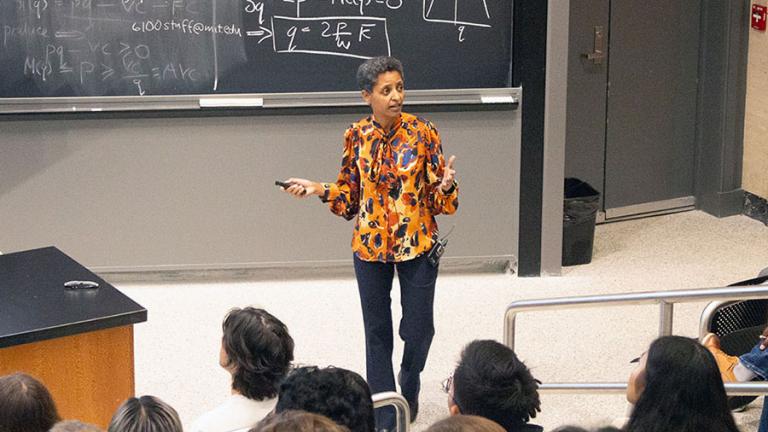
Renewable energy today — mainly derived from the sun or wind — depends on batteries for storage. While costs have dropped in recent years, the pursuit of more efficient means of storing renewable power continues.
“All of these technologies, unfortunately, have a long way to go,” said Sossina Haile SB ’86, PhD ’92, the Walter P. Murphy Professor of Materials Science and Engineering at Northwestern University, at recent talk at MIT. She was the speaker of the fall 2023 Wulff Lecture, an event hosted by the Department of Materials Science and Engineering (DMSE) to ignite enthusiasm for the discipline.
To add to the renewable energy mix — and help quicken the pace to a sustainable future — Haile is working on an approach based on hydrogen in fuel cells, particularly for eco-friendly fuel in cars. Fuel cells, like batteries, produce electricity from chemical reactions but don’t lose their charge so long as fuel is supplied.
To generate power, the hydrogen must be pure — not attached to another molecule. Most methods of producing hydrogen today require burning fossil fuel, which generates planet-heating carbon emissions. Haile proposes a “green” process using renewable electricity to extract the hydrogen from steam.
When hydrogen is used in a fuel cell, “you have water as the product, and that’s the beautiful zero emissions,” Haile said, referring to the renewable energy production cycle that is set in motion.
Ammonia fuels hydrogen’s potential
Hydrogen is not yet widely used as a fuel because it’s difficult to transport. For one, it has low energy density, meaning a large volume of hydrogen gas is needed to store a large amount of energy. And storing it is challenging because hydrogen’s tiny molecules can infiltrate metal tanks or pipes, causing cracks and gas leakage.
Haile’s solution for transporting hydrogen is using ammonia to “carry” it. Ammonia is three parts hydrogen and one part nitrogen, so the hydrogen needs to be separated from the nitrogen before it can be used in the kind of fuel cells that can power cars.
Ammonia has some advantages, including using existing pipelines and a high transmission capacity, Haile said — so more power can be transmitted at any given time.
To extract the hydrogen from ammonia, Haile has built devices that look a lot like fuel cells, with cesium dihydrogen phosphate as an electrolyte. The “superprotonic” material displays high proton conductivity — it allows protons, or positively charged particles, to move through it. This is important for hydrogen, which has just a proton and an electron. By letting only protons through the electrolyte, the device strips hydrogen from the ammonia, leaving behind the nitrogen.
The material has other benefits, too, Haile said: “It’s inexpensive, nontoxic, earth-abundant — all these good things that you want to have when you think about a sustainable energy technology.”
Sparking interest — and hope
Haile’s talk piqued interest in the audience, which nearly filled the 6-120 auditorium at MIT, which seats about 150 people.
Materials science and engineering major Nikhita Law heard hope in Haile’s talk for a more sustainable future.
“A major problem in making our energy system sustainable is finding ways to store energy from renewables,” Law says. Even if hydrogen-powered cars are not as wide-scale as lithium-battery-powered electric cars, “a permanent energy storage station where we convert electricity into hydrogen and convert it back seems like it makes more sense than mining more lithium.”
Another DMSE student, senior Daniel Tong, learned about the challenges involved in transporting hydrogen at another seminar and was curious to learn more. “This was something I hadn't thought of: Can you carry hydrogen more effectively in a different form? That’s really cool.”
He adds that talks like the Wulff Lecture are helpful in keeping people up to date in a wide-ranging, interdisciplinary field such as materials science and engineering, which spans chemistry, physics, engineering, and other disciplines. “This is a really good way to get exposed to different parts of materials science. There are so many more facets than you know of.”
In her talk, Haile encouraged audience members to get involved in sustainability research.
“There’s lots of room for further insight and materials discovery,” she said.
Haile concluded by underscoring the challenges faced by developing countries in dealing with climate change impacts, particularly those near the equator where there isn’t adequate infrastructure to deal with big swings in precipitation and temperature. For the people who aren’t driven to solve problems that affect people on the other side of the world, Haile offered some extra motivation.
“I’m sure many of you enjoy coffee. This is going to put the coffee crops in jeopardy as well,” she said.






